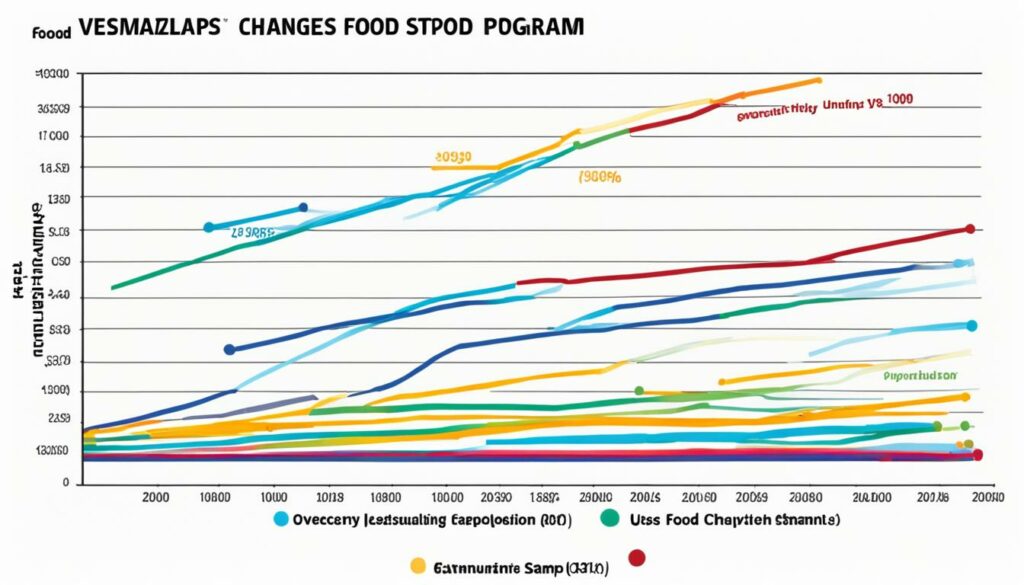Originally posted on February 10, 2024 @ 6:05 pm
The Electronic Benefit Transfer (EBT) program has revolutionized the way government assistance benefits are distributed in the United States. But when did EBT start and how did it become the efficient system we know today?
EBT has its origins in the first Food Stamp Program established back in 1939. However, it wasn’t until the 1960s that the foundations of the modern EBT system began to take shape. Over the years, the program experienced significant expansion, legislative changes, and the development of electronic payment technology.
In this article, we’ll dive into the history of the EBT program, from its early beginnings to its current state, and explore the key milestones in its development.
Table of Contents
Key Takeaways:
- The first Food Stamp Program was established in 1939 as a response to the economic challenges of the Great Depression.
- The modern EBT system started taking shape in the 1960s with the pilot Food Stamp Program.
- The Food Stamp Act of 1964 established the foundation for the modern Food Stamp Program.
- The program experienced significant expansion in the 1960s and 1970s, reaching nationwide coverage in 1974.
- The development of Electronic Benefit Transfer (EBT) began in the late 1980s and early 1990s, introducing electronic payment technology.
The First Food Stamp Program (1939)

In 1939, the first food stamp program was established in response to the economic challenges faced during the Great Depression. This program aimed to assist individuals and families by providing them with the means to purchase food.
Under the program, individuals on relief could purchase orange stamps equivalent to their normal food expenditures. For every $1 worth of orange stamps purchased, they received 50 cents worth of blue stamps. Orange stamps could be used to buy any food, while blue stamps were limited to purchasing surplus food identified by the Department of Agriculture.
The initial recipient of food stamps was Mabel McFiggin in Rochester, New York, on May 16, 1939. The program experienced significant success, reaching approximately 20 million people at its peak and costing a total of $262 million.
Food Stamp Program Overview
| Year | Program | Number of Participants | Total Cost (in millions) |
|---|---|---|---|
| 1939 | The First Food Stamp Program | Not Applicable | Not Applicable |
| Peak (Estimated) | Food Stamp Program | 20 million | $262 |
| EBT Program | Not Applicable | Not Applicable |
The first food stamp program laid the foundation for future developments in assisting individuals and families in need of food assistance. It served as a precursor to the modern Electronic Benefit Transfer (EBT) system.
Pilot Food Stamp Program (1961-1964)

Between 1961 and 1964, the pilot Food Stamp Program was launched as a precursor to the modern EBT system. President Kennedy initiated the pilot programs to address the issue of hunger and food insecurity in the United States. These pilot programs aimed to increase the consumption of perishable foods and expand food distribution to those in need.
During the pilot Food Stamp Program, participants were able to purchase food stamps, which could be used to buy a variety of food items. However, there was a particular emphasis on increasing the consumption of perishable foods, such as fruits, vegetables, and dairy products. This approach aimed to improve the overall nutritional quality of participants’ diets.
The initial pilot programs started with only eight areas, but quickly expanded to 43 areas across 22 states as their effectiveness became evident. By January 1964, approximately 380,000 individuals were participating in the pilot Food Stamp Program.
The pilot Food Stamp Program laid the foundation for the establishment of the modern Electronic Benefit Transfer (EBT) system. It demonstrated the potential of using electronic payment technology to streamline food assistance programs and improve access to nutritious foods.
Food Stamp Act of 1964

The Food Stamp Act of 1964 was a groundbreaking legislation that laid the foundation for the modern Food Stamp Program. Signed into law by President Lyndon B. Johnson, this act aimed to address the pressing issues of strengthening the agricultural economy and improving nutrition among low-income households.
The Food Stamp Act of 1964 mandated states to develop their own eligibility standards and purchase requirements for individuals and families seeking food stamp assistance. By delegating this responsibility to the states, the act ensured that the program could be tailored to the unique needs of each jurisdiction and effectively administered.
One of the key provisions of the act was the prohibition of discrimination in the food stamp program. This ensured that individuals would not be denied participation based on race, color, religion, national origin, or political beliefs. The act emphasized the importance of equal access to food assistance for all eligible individuals, promoting fairness and inclusivity.
Furthermore, the Food Stamp Act of 1964 provided crucial funding for the program. With an estimated cost of $360 million annually, the act allocated resources to support the implementation and operation of the food stamp program across the country. This financial support was essential in ensuring that the program could effectively serve those in need.
The Food Stamp Act of 1964 had a far-reaching vision of alleviating hunger and improving the well-being of vulnerable populations. It estimated that the participation in the program would eventually reach 4 million people, underscoring the scale and significance of the initiative.
| Key Provisions | Impact |
|---|---|
| Mandated states to develop eligibility standards and purchase requirements | Ensured tailored program administration and effective implementation |
| Prohibited discrimination based on race, color, religion, national origin, or political beliefs | Promoted equal access and inclusivity |
| Provided funding for the program | Supported implementation and operation |
| Estimated participation of 4 million people | Significant reach and impact on individuals and families |
In conclusion, the Food Stamp Act of 1964 was a landmark legislation that established the modern Food Stamp Program. Through its provisions on eligibility, discrimination prevention, funding, and projected participation, the act laid the groundwork for a comprehensive and impactful approach to addressing food insecurity in the United States.
Program Expansion (1960s-1970s)
The 1960s and early 1970s mark a significant period of growth and expansion for the food stamp program. During this time, the program witnessed an exponential increase in the number of participants, reaching several milestones that highlight its substantial growth.
In 1965, the program achieved a significant milestone with half a million participants. This marked a turning point, demonstrating the program’s ability to provide essential assistance to those in need. Just a year later, in 1966, the number of participants doubled, surpassing the one million mark, highlighting the program’s increasing relevance and impact.
“The food stamp program has played a pivotal role in alleviating hunger and providing critical support to families in need”
The real breakthrough came in 1971 when participation in the program skyrocketed to an impressive 10 million individuals. This unprecedented growth showcases the program’s ability to reach an increasing number of people, making a tangible difference in their lives.
As the program expanded geographically and gained wider recognition, its reach continued to grow. By October 1974, the food stamp program reached a remarkable 15 million participants, cementing its position as a vital resource for individuals and families across the nation.
The Growth of the Food Stamp Program
The table below presents a summary of the program’s growth during the 1960s and 1970s, highlighting the significant increase in participants.
| Year | Number of Participants |
|---|---|
| 1965 | 500,000 |
| 1966 | 1,000,000 |
| 1971 | 10,000,000 |
| October 1974 | 15,000,000 |
This table provides a clear representation of the program’s growth over the years, highlighting the continuous increase in participants during the 1960s and 1970s.
The program’s expansion during this period demonstrates its ability to meet the rising demand for food assistance across the country, ensuring that individuals and families in need have access to the vital resources necessary for their well-being.
Major Legislative Changes (1971-1974)

The early 1970s marked a significant period of legislative changes that shaped the food stamp program. These alterations aimed to improve program access and accountability, making notable advancements in ensuring food assistance for those in need.
Food Stamp Act Amendment of 1970
The Food Stamp Act Amendment of 1970 introduced national eligibility standards and work registration requirements. This amendment established consistent criteria across states, ensuring that individuals who met the eligibility criteria could access the program’s benefits. Additionally, work registration requirements were implemented to promote self-sufficiency and encourage participants to actively seek employment.
Agriculture and Consumer Protection Act of 1973
The Agriculture and Consumer Protection Act of 1973 expanded the food stamp program to include drug addicts, alcoholics in treatment, and individuals residing in rehabilitation centers. This expansion aimed to provide assistance to vulnerable populations facing addiction and improved access to essential nutrition during their journey towards recovery.
PL 93-347
PL 93-347, enacted in 1974, authorized the Department of Agriculture to cover 50% of states’ administrative costs associated with administering the food stamp program. This allowed states to allocate their resources more effectively, ensuring the program’s efficient operation while fostering financial sustainability.
These legislative changes in the early 1970s were vital steps towards enhancing the food stamp program’s impact on individuals and communities in need. By expanding eligibility, promoting work registration, and providing administrative support, these changes helped strengthen the program’s accessibility and accountability.
Nationwide Program (1974)

In 1974, the Food Stamp Program underwent a significant expansion, becoming a nationwide program and reaching all political jurisdictions within the United States. This expansion marked a pivotal moment in the program’s history, as it extended access to food stamps to eligible individuals and families across the entire country. The nationwide implementation of the program aimed to address food insecurity and provide much-needed assistance to those in need.
By November 1974, the program was fully implemented in Puerto Rico, ensuring that residents of the territory also had access to the benefits offered by the Food Stamp Program. This expansion allowed more individuals and families to participate in the program and receive the support they needed to put food on their tables.
The nationwide expansion of the Food Stamp Program not only increased participation but also helped to create greater awareness of the program’s availability and benefits. As a result, more individuals who were eligible for food stamps were able to access the assistance they needed to meet their nutritional needs and improve their overall well-being.
Implementing the program nationwide required collaboration between federal, state, and local governments to ensure effective administration and delivery of benefits. The expansion of the Food Stamp Program served as a testament to the commitment of the government to address hunger and support vulnerable populations throughout the United States.
Development of Electronic Benefit Transfer (EBT) (1988-2004)

The Electronic Benefit Transfer (EBT) system revolutionized the distribution of benefits by replacing traditional paper food stamps with electronic payment technology. This development occurred between 1988 and 2004, marking a significant milestone in the history of electronic benefit transfer.
EBT brought about numerous advantages, improving the efficiency of benefit distribution, reducing fraud, and enhancing convenience for recipients. The gradual shift from paper-based systems to electronic payment methods transformed the way benefits were accessed and utilized.
The implementation of EBT had far-reaching implications, streamlining the process for both beneficiaries and the administering authorities. It eliminated the need for physical handling and ensured faster, more secure transactions.
In addition, EBT allowed recipients to access their benefits through electronic payment cards, which could be used at authorized retailers. This provided individuals and families with greater autonomy, enabling them to purchase food and essential supplies with ease and dignity.
The development of EBT was guided by the goal of improving the delivery of benefits to those in need. By eliminating the complexity of paper-based systems, EBT reduced administrative costs and enhanced program integrity.
“The implementation of EBT marked a significant turning point in benefit distribution, leveraging electronic payment technology for greater efficiency and convenience.”
The introduction of EBT not only modernized the distribution process but also paved the way for future innovations in benefit delivery. It laid the foundation for enhanced data tracking, improved program evaluation, and the potential integration of additional support services in the years to come.
Legislative Actions and Program Changes (1993-2009)

During the period from 1993 to 2009, the food stamp program underwent significant changes through various legislative actions. These actions aimed to improve the effectiveness and impact of the program, addressing specific issues and concerns. Let’s take a closer look at some of the key legislative changes and program modifications that occurred during this time:
The Mickey Leland Childhood Hunger Relief Act (1993)
The Mickey Leland Childhood Hunger Relief Act, passed in 1993, was a crucial legislative action designed to address childhood hunger in the United States. Named after the late Congressman Mickey Leland, this act aimed to expand access to food assistance programs for children in need. It recognized the importance of ensuring that children have access to nutritious meals, especially during critical stages of development.
The Personal Responsibility and Work Opportunity Reconciliation Act (1999-2001)
The Personal Responsibility and Work Opportunity Reconciliation Act, passed between 1999 and 2001, introduced significant welfare reform measures that had an impact on the food stamp program. This act aimed to promote self-sufficiency among recipients, emphasizing the importance of work, personal responsibility, and accountability. It introduced requirements and provisions related to work activities, time limits, and eligibility criteria for receiving assistance.
The Farm Security and Rural Investment Act (2002) and the Food, Conservation, and Energy Act (2008)
The Farm Security and Rural Investment Act of 2002 and the Food, Conservation, and Energy Act of 2008 brought about substantial changes to the food stamp program. These acts sought to address various aspects of the program, including eligibility criteria, benefit calculations, and program oversight. They introduced provisions to improve access to healthy foods, promote nutrition education, and enhance program integrity.
These legislative actions and program changes during the period from 1993 to 2009 reflected a continuous effort to enhance the food stamp program and ensure that it effectively supports individuals and families facing food insecurity. They aimed to address specific challenges and create a more accessible, accountable, and nutrition-focused program.
| Legislative Action | Year |
|---|---|
| The Mickey Leland Childhood Hunger Relief Act | 1993 |
| The Personal Responsibility and Work Opportunity Reconciliation Act | 1999-2001 |
| The Farm Security and Rural Investment Act | 2002 |
| The Food, Conservation, and Energy Act | 2008 |
These legislative actions and program changes played a vital role in shaping the food stamp program and addressing critical issues related to hunger and poverty in the United States.
Healthy, Hunger-Free Kids Act (2010)
In 2010, the Healthy, Hunger-Free Kids Act was enacted, focusing on improving nutrition in the food stamp program. This act aimed to promote healthy eating habits among program participants and provide access to nutritious food options. It was part of a larger effort to combat childhood obesity and improve the overall health and well-being of individuals and families receiving food stamps.
The Healthy, Hunger-Free Kids Act recognized the importance of nutrition in promoting optimal growth and development, particularly in young children. By prioritizing healthier food choices, the act aimed to address the nutritional needs of vulnerable populations and reduce the risk of diet-related health issues.
Under this legislation, the food stamp program implemented various measures to support healthy eating. This included the introduction of nutrition standards for school meals and the implementation of the National School Lunch Program and the School Breakfast Program. These programs aimed to provide nutritious meals to students, ensuring they have access to balanced meals that meet their nutritional needs.
The act also promoted the consumption of fruits and vegetables, emphasizing their importance in a well-rounded diet. It encouraged the adoption of strategies and initiatives that would make it easier for program participants to access and afford fresh produce, such as farmers’ markets and community-supported agriculture programs.
Promoting Healthy Eating Habits
The Healthy, Hunger-Free Kids Act adopted a multi-faceted approach to promote healthy eating habits among food stamp program participants:
- Improving nutrition standards for school meals: The act set new nutrition guidelines to ensure that meals served in schools are nutritious and well-balanced. This included increasing the availability of fruits, vegetables, whole grains, and lean proteins, while limiting the amounts of sodium, saturated fat, and added sugars.
- Expanding access to healthy food options: The act aimed to increase access to fresh fruits and vegetables by supporting initiatives like farm-to-school programs, farmers’ markets, and community gardens. These efforts aimed to improve food accessibility and affordability in underserved communities.
- Providing nutrition education: The act emphasized the importance of nutrition education to equip program participants with the knowledge and skills to make healthy food choices. It encouraged the development and implementation of nutrition education programs that would empower individuals and families to adopt healthier eating habits.
The Healthy, Hunger-Free Kids Act represented a significant step forward in improving the nutritional quality of the food stamp program. By prioritizing healthy eating habits and fostering access to nutritious food options, the act aimed to support the overall health and well-being of program participants, particularly children. It underscored the belief that every individual, regardless of their socioeconomic status, deserves access to quality, nutritious food to thrive and reach their full potential.
Agricultural Act of 2014
The Agricultural Act of 2014, also known as the 2014 Farm Bill, brought significant changes to the food stamp program. This legislation aimed to improve the nutritional value of food stamp purchases and promote healthier choices for participants.
One of the key provisions of the Agricultural Act of 2014 authorized the U.S. Department of Agriculture (USDA) to provide funding for programs that encourage the purchase of fruits and vegetables by SNAP (Supplemental Nutrition Assistance Program) participants. This provision aimed to increase access to fresh, nutritious produce and support healthier eating habits.
The act also specified the exclusion of certain items from the food stamp program. Alcoholic beverages, tobacco products, hot food, and food sold for on-premises consumption were among the items that participants could no longer purchase using food stamps. This change aimed to ensure that food stamp benefits were used for essential groceries rather than non-nutritious or luxury items.
The Agricultural Act of 2014 marked an important shift in the food stamp program, highlighting the government’s commitment to promoting healthier food choices and improving the well-being of program participants.
| Provisions | Impact |
|---|---|
| Authorization of funding for fruit and vegetable purchase programs | Increased access to fresh, nutritious produce for SNAP participants |
| Exclusion of alcoholic beverages, tobacco products, hot food, and food sold for on-premises consumption | Ensured food stamp benefits were used for essential groceries, promoting healthier choices |
Conclusion
The Electronic Benefit Transfer (EBT) system has revolutionized the way food assistance programs operate in the United States. From its humble beginnings in the first food stamp program of 1939 to its current state, EBT has undergone significant changes and advancements to better support millions of Americans in need of food assistance.
Legislative changes over the years have played a crucial role in the growth and evolution of the EBT system. These changes have not only expanded the program’s reach but also improved efficiency and reduced fraud. From the establishment of national eligibility standards to the development of electronic payment technology, EBT has become a more convenient and accessible means of distributing benefits to eligible individuals and families.
As the EBT system continues to evolve, there will likely be further efforts to promote healthy nutrition and improve the overall well-being of program participants. Initiatives such as the Healthy, Hunger-Free Kids Act and the Agricultural Act of 2014 reflect the constant strive to provide nutritious food options and make healthier choices more accessible.
In conclusion, the Electronic Benefit Transfer (EBT) system has transformed the landscape of food assistance programs in the United States. Through a rich history of legislative changes and technological advancements, EBT has become a vital lifeline for millions of Americans, improving efficiency, reducing fraud, and providing greater convenience and access to food benefits. As the program continues to adapt to changing needs, it remains committed to supporting individuals and families in their journey towards food security and overall well-being.
FAQ
When did the Electronic Benefit Transfer (EBT) system start?
The origins of the EBT system can be traced back to the first Food Stamp Program in 1939. However, the modern EBT system began to take shape in the 1960s and 1970s, with significant developments in the late 1980s and early 1990s.
What was the first food stamp program?
The first food stamp program was established in 1939 as a response to the economic challenges of the Great Depression. It allowed people on relief to purchase food stamps to buy food. The program reached approximately 20 million people at its peak.
When was the pilot food stamp program launched?
The pilot food stamp program was launched between 1961 and 1964 as a precursor to the modern EBT system. It started with eight areas and expanded to 43 in 22 states, reaching 380,000 participants by January 1964.
When was the Food Stamp Act of 1964 enacted?
The Food Stamp Act of 1964 was signed into law by President Johnson. It established the modern Food Stamp Program, requiring states to develop eligibility standards and purchase requirements for recipients. The act aimed to strengthen the agricultural economy and improve nutrition among low-income households.
How did the food stamp program expand in the 1960s and 1970s?
The food stamp program experienced significant expansion during this period, with milestones such as reaching half a million participants in 1965, 1 million in 1966, and 10 million in 1971. The program continued to grow, reaching 15 million participants in October 1974.
What were the major legislative changes in the food stamp program between 1971 and 1974?
Major legislative changes during this period included the establishment of national eligibility standards and work registration requirements in 1970, the expansion of the program to drug addicts, alcoholics in treatment, and rehabilitation centers in 1973, and the authorization of the Department of Agriculture to pay 50% of states’ administrative costs in 1974.
When did the food stamp program become a nationwide program?
In 1974, the food stamp program became a nationwide program, reaching all political jurisdictions within the United States. The program was fully implemented in Puerto Rico by November 1974.
When was the Electronic Benefit Transfer (EBT) system developed?
The development of the EBT system took place between 1988 and 2004. It replaced traditional paper food stamps and introduced electronic payment technology for the distribution of benefits. This shift improved efficiency, reduced fraud, and provided recipients with greater convenience and access to their benefits.
What were the major legislative actions and program changes in the food stamp program between 1993 and 2009?
Legislative actions during this period included the Mickey Leland Childhood Hunger Relief Act in 1993, the Personal Responsibility and Work Opportunity Reconciliation Act from 1999 to 2001, and the Farm Security and Rural Investment Act of 2002 and the Food, Conservation, and Energy Act of 2008. These changes impacted various aspects of the program.
What was the Healthy, Hunger-Free Kids Act of 2010?
The Healthy, Hunger-Free Kids Act was enacted in 2010, focusing on improving nutrition in the food stamp program. It aimed to promote healthy eating habits among program participants and provide access to nutritious food options as part of a larger effort to combat childhood obesity and improve overall health.
What changes were made by the Agricultural Act of 2014?
The Agricultural Act of 2014, also known as the 2014 Farm Bill, made various changes to the food stamp program. It authorized the USDA to provide funding for programs that encourage the purchase of fruits and vegetables by SNAP participants and specified exclusions for certain items, such as alcoholic beverages, tobacco products, hot food, and food sold for on-premises consumption.
What is the summary of the EBT system’s history?
The EBT system has evolved over time, starting with the first food stamp program in 1939 and going through significant developments in the 1960s, 1970s, and beyond. The EBT system as we know it today began to take shape in the late 1980s and early 1990s with the development of electronic payment technology. It has improved efficiency, reduced fraud, and provided recipients with greater convenience and access to their benefits.
Source Links
- https://www.history.com/news/food-stamps-great-depression
- https://www.fns.usda.gov/snap/short-history-snap
- https://www.snaptohealth.org/snap/the-history-of-snap/
See also:
Leave a Reply